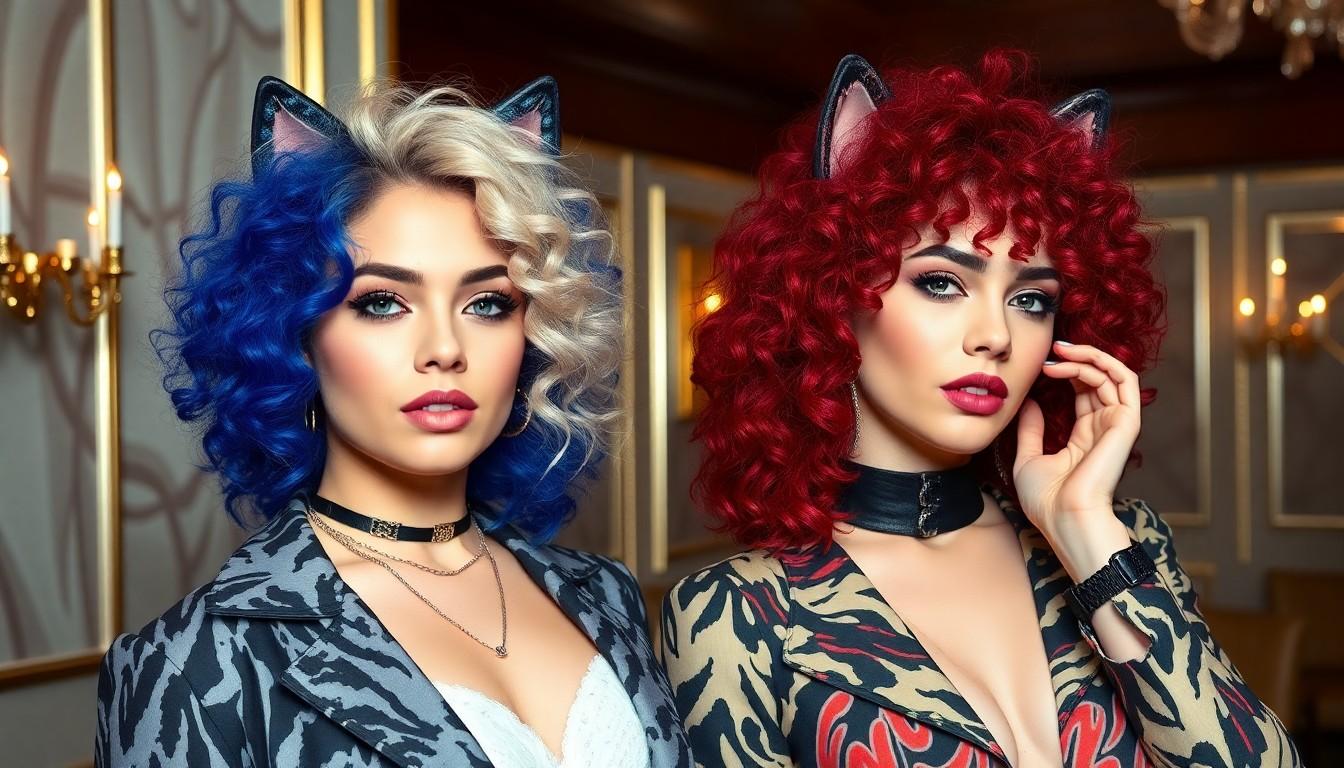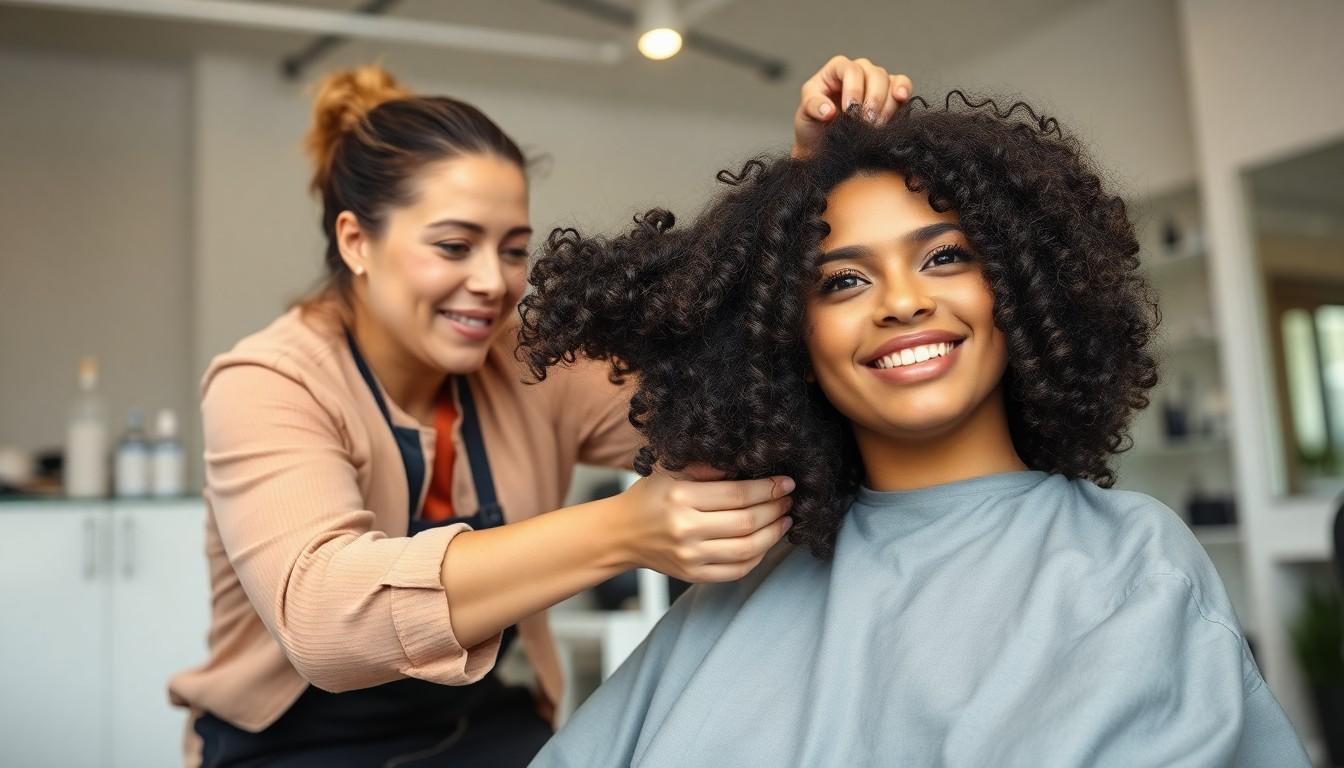Ready to transform your curly locks? The curly wolf cut is taking the hair industry by storm, combining the wild freedom of a shag with the structured elegance of a wolf cut. We’re seeing this versatile style everywhere from social media feeds to celebrity red carpets.
What makes this trend so irresistible is how it embraces natural texture while adding movement and dimension. Perfect for curly hair types from 2A to 4C, the wolf cut enhances your natural bounce while reducing bulk and creating that coveted face-framing effect. It’s the ultimate low-maintenance style that still delivers maximum impact.
Understanding the Curly Wolf Cut: A Modern Twist on a Classic Style
The curly wolf cut represents a fresh interpretation of the classic wolf haircut, specifically designed to enhance and celebrate natural curls. This innovative style combines the layered structure of the traditional wolf cut with thoughtful modifications that work harmoniously with curly hair textures. Many stylists have embraced this adaptation because it maintains the edgy essence of the original while creating a more voluminous, bouncy result for curly-haired clients.
At its core, the curly wolf cut features shorter layers around the crown that gradually transition to longer lengths toward the bottom. These strategic layers remove excess weight from curly hair, allowing natural ringlets to spring up and create that coveted mushroom-like shape. Wolf cuts for curly hair typically incorporate face-framing pieces that highlight facial features while maintaining enough length to showcase curl patterns.
What truly sets the curly wolf cut apart is its versatility across different curl types, from loose waves to tight coils. Each variation of the cut can be customized to accommodate exact curl patterns, with tighter curls often requiring less dramatic layering to achieve the desired effect. Texture plays a crucial role in how the final result appears, as curly hair naturally creates volume and dimension that straight hair would need additional styling to achieve.
Unlike its straight-haired counterpart, the curly wolf cut often looks different day by day, embracing the unpredictable nature of curly hair as part of its charm. This adaptability makes it an excellent choice for those who appreciate a haircut that can transform from casual to sophisticated with minimal effort. The style’s growing popularity stems from its ability to work with rather than against natural texture, creating a personalized look that enhances each person’s unique curl pattern.
The Evolution of the Wolf Cut for Curly Hair

The wolf cut has undergone a fascinating evolution, especially when paired with curly hair. This unique style has transformed from a niche trend to a mainstream favorite, adapting beautifully to enhance natural curls.
Origins of the Wolf Cut
The wolf cut finds its roots in a creative fusion of two iconic hairstyles from different decades. Blending the layered shag of the 1970s with the business-in-front, party-in-back mullet of the 1980s, this hybrid style creates a distinctively textured look that’s simultaneously retro and modern. Pop culture has significantly influenced the rise of this trend, with celebrities like Billie Eilish and Natasha Lyonne showcasing their versions of the cut. Their high-profile adoption of the style has propelled the wolf cut into the fashion spotlight, making it a sought-after choice for those looking to refresh their look with something both edgy and nostalgic.
How Curly Textures Transform the Wolf Cut
Curly hair naturally elevates the wolf cut to new heights by adding inherent volume and dimension. The strategic layers characteristic of this cut enhance the crown’s natural fullness, creating a ever-changing silhouette that celebrates rather than tames curly textures. Choppy layers throughout the style highlight each curl’s natural pattern, resulting in a bold, multi-dimensional appearance that straight hair simply can’t replicate. The wolf cut particularly flatters curly hair by emphasizing and showcasing each individual curl, allowing them to spring freely and create depth within the style. Maintenance becomes remarkably simple with this cut, as it’s designed to look deliberately undone and effortlessly tousled, permitting curls to fall naturally without excessive styling. Versatility stands as one of the cut’s greatest strengths, with adaptations available for every curl type from loose waves to tight coils, making it an incredibly inclusive style choice for the diverse spectrum of curly hair textures.
10 Reasons Why the Curly Wolf Cut Is Trending in 2023

1. Incredible Versatility
The curly wolf cut offers remarkable versatility, adapting to various styling preferences and occasions. Whether you’re heading to a formal event or keeping it casual, this ever-changing haircut transitions seamlessly between looks. Many style enthusiasts appreciate how the cut can be worn tousled for a relaxed weekend vibe or more polished for professional settings.
2. Strategic Intermittent Layering
This trending style features carefully placed intermittent layers that work specifically with curly hair textures. The strategic layering technique adds dimension, movement, and structure to curls without creating a bottom-heavy effect. Professional stylists use this approach to enhance natural curl patterns while maintaining an overall cohesive shape.
3. Enhanced Volume and Texture
The curly wolf cut dramatically amplifies volume and texture, especially for those with naturally curly hair. By removing weight in key areas, this cut allows curls to spring up naturally around the crown and face-framing sections. The resulting fullness creates a balanced silhouette that many find flattering for various face shapes.
4. Low Maintenance Appeal
Even though its stylish appearance, the curly wolf cut remains surprisingly low maintenance for everyday wear. Its effortless design works with natural curl patterns rather than fighting against them. Many wearers report spending less time styling their hair while still achieving a polished, intentional look.
5. Social Media Explosion
TikTok and Instagram have catapulted the curly wolf cut into mainstream popularity through viral transformation videos and styling tutorials. Hashtags featuring this cut have garnered millions of views across platforms, with content creators showcasing dramatic before-and-after results. The visual impact of these transformations continues driving curiosity and adoption.
6. Celebrity Endorsement
Many celebrities and influencers have embraced the curly wolf cut, significantly boosting its visibility and desirability. Their high-profile appearances sporting this style across media channels have inspired fans to try the look for themselves. Celebrity stylists often promote the cut’s benefits for those with natural texture.
7. Bold and Rebellious Aesthetic
The curly wolf cut delivers a distinctively bold, rebellious look that appeals to those seeking to make a statement. Its playful yet edgy appearance offers a refreshing alternative to more conventional hairstyles. Many adopt this cut as a form of self-expression and confidence-boosting transformation.
8. Customizable Options
Stylist flexibility makes the curly wolf cut highly customizable to individual preferences and exact curl patterns. From adding choppy short tassels for extra texture to adjusting layer placement for different face shapes, this adaptable style can be customized to suit personal tastes. The cut works effectively across diverse curl types from loose waves to tight coils.
9. Accessory Compatibility
The curly wolf cut pairs beautifully with various hair accessories that enhance its overall appeal. Silver-toned clips, decorative pins, and stylish headbands complement the cut’s dimensional layers. These accessories can transform the look for different occasions while maintaining the cut’s signature shape.
10. Natural Texture Enhancement
Working harmoniously with natural curl patterns, this cut stacks curls strategically for a cohesive appearance. The technique of trimming tighter at the bottom while maintaining fullness at the top creates an intentional shape that celebrates rather than constrains natural texture. This approach results in a haircut that looks deliberately styled even on wash-and-go days.
How to Ask Your Stylist for the Perfect Curly Wolf Cut

Communication is crucial when requesting this trendy cut. Here’s how to ensure your stylist understands exactly what you’re looking for when asking for a curly wolf cut.
Key Terminology to Use
Mastering the right vocabulary helps translate your vision clearly to your stylist. Start by requesting “choppy, textured layers” that will enhance your curl pattern and add important volume and movement. Emphasize your desire for a “heavily layered look” that creates dimension throughout your hair. Ask for “face-framing pieces” with shorter layers around your face to accentuate your features without overwhelming your curls. Mention that you want an “edgy finish” with slightly jagged or wispy ends for that effortlessly cool, lived-in feel. Use the term “mullet-inspired” to communicate that you’re looking for a style that combines elements of both a shag and mullet but customized specifically for curly hair. Request layers that will boost the “natural volume” of your curls while maintaining a “messy, textured look” that complements your curl pattern.
Bringing Reference Photos That Work
Visual examples dramatically improve communication with your stylist. Bring multiple photos of curly wolf cuts that match your desired outcome, specifically selecting images featuring hair with similar curl patterns to yours. Point out exact details in each photo, such as the length of layers, texture distribution, and how the hair frames the face. This precise guidance ensures your stylist captures the exact look you want. Consider mentioning that you’re open to customization based on your unique hair type and personal style. Photos of curly wolf cuts from different angles provide a comprehensive view of the style, helping your stylist understand the overall shape and movement you’re seeking. If you’re interested in adding curtain bangs, bring separate reference photos showing how they complement the curly wolf cut by adding structure around your face.
Styling Your Curly Wolf Cut: Essential Products and Techniques

To achieve the perfect curly wolf cut, you’ll need the right products and techniques to enhance your natural texture while maintaining the cut’s distinctive shape. We’ve compiled the essential styling elements that will help you make the most of this trendy hairstyle.
Daily Maintenance Routine
Regular Trims
Maintaining your curly wolf cut requires scheduling trims every 6-8 weeks. These regular appointments prevent split ends and help preserve the shape of your layered cut, ensuring your curls continue to fall beautifully according to the design.
Deep Conditioning
Treating your curls to a weekly deep conditioning mask is crucial for curly wolf cuts. This essential step keeps your curls hydrated and strong, preventing the dryness that can make curly hair lose its defined shape and bounce.
Nighttime Care
Sleeping on a silk or satin pillowcase drastically reduces friction that can disturb your curl pattern and cause frizz. For additional protection, try securing your hair in a loose pineapple bun before bed to prevent tangles and maintain your style through the night.
Best Styling Tools for Curly Wolf Cuts
Scissors
Sharp, high-quality scissors are essential for maintaining your curly wolf cut at home. Professional stylists recommend using the point-cutting technique, which involves snipping into the ends of each section at an angle to create soft, natural-looking layers.
Clips
Sectioning clips help divide your hair into manageable portions while cutting or styling. These simple tools allow for precise work on exact areas while keeping the rest of your hair neatly out of the way.
Flat Iron
For those with layered short bangs, a flat iron offers versatility in styling options. You can use it to smooth out your bangs for a more polished appearance or create different textures throughout your wolf cut.
Finger Styling
Simply running your fingers through your curls can be one of the most effective styling techniques, especially for those with thick hair. This natural approach enhances your curl pattern while maintaining the tousled, effortless look that makes the wolf cut so appealing.
Styling Products
Improving your curly wolf cut requires the right product arsenal. Volumizing mousse adds body and definition to curls throughout your layered cut. Sea salt spray creates beachy texture and enhances natural waves. For a more polished finish, pomade or wax can help define exact pieces and tame any flyaways. When applied strategically to your layers, these products highlight the dimensional nature of the wolf cut while embracing your natural curl pattern.
Celebrity Inspiration: Famous Faces Rocking the Curly Wolf Cut

Billie Eilish
Billie Eilish stands at the forefront of celebrities who’ve popularized the curly wolf cut trend. Her bold style choices have made this edgy haircut even more mainstream, showcasing how the cut perfectly enhances natural volume and texture. Many fans have followed Eilish’s lead after seeing how the layered style frames her face while maintaining that signature rebellious vibe she’s known for. The singer’s take on the curly wolf cut demonstrates its versatility, proving that this style works wonderfully for those looking to make a statement with their hair.
Natasha Lyonne
Natasha Lyonne embraces her natural curls with a stunning wolf cut that’s become part of her iconic look. Celebrity hairstylist Stanwell deserves credit for crafting this perfect adaptation that enhances Lyonne’s natural curl pattern while adding an unmistakable edge. Her version of the curly wolf cut showcases how the style can be customized to different face shapes while maintaining its distinctive choppy, layered aesthetic. Lyonne’s interpretation has inspired countless fans to experiment with this trend, especially those with naturally curly hair who previously might have avoided heavily layered cuts.
The influence of these celebrities has significantly contributed to the curly wolf cut’s explosive popularity on social media platforms like TikTok. Their high-profile endorsements demonstrate how this versatile style works across different curl patterns and personal aesthetics. Fashion-forward individuals looking for inspiration need only look to these trendsetters for proof that the curly wolf cut offers both style and substance for those blessed with natural texture.
How to Customize Your Curly Wolf Cut for Different Face Shapes

Oval Face Shape
Oval faces enjoy the most versatility with curly wolf cuts. We recommend trying classic, asymmetrical, or long layered variations that complement your balanced proportions. Face-framing layers enhance your natural features while curly bangs add dimension and style. Your oval shape allows for experimentation with various layer lengths and positioning, making it easy to find a personalized look that accentuates your natural beauty.
Round Face Shape
Round faces benefit from strategic layering that creates a slimming effect. We suggest opting for choppy, short layers around the face to help elongate your features and add definition. Starting layers higher up on the head draws the eye upward, creating the illusion of a longer face. The textured nature of the curly wolf cut naturally breaks up the roundness, offering a flattering frame that enhances your facial structure.
Heart-Shaped Face
Heart-shaped faces look stunning with layers that start around the jawline. We find this technique helps balance wider foreheads and temples while drawing attention to your lower face. Soft, curly bangs effectively soften angular features, creating harmony throughout your face. The playful texture of the curly wolf cut works wonderfully to complement your natural bone structure while maintaining the style’s signature edgy appeal.
Oblong Face Shape
Oblong faces pair best with shorter wolf cuts that add width rather than length. We advise against extremely long variations that might further elongate your face. Instead, focus on creating volume at the sides with strategically placed layers that build outward. This approach helps balance your proportions while maintaining the distinctive wolf cut aesthetic that celebrates your natural curls.
Customization Tips
Texture and layers form the foundation of a personalized curly wolf cut. We emphasize that strategically placed layers define curls, reduce bulk, and maintain volume in curly hair types. Soft layers enhance wavy textures, while coily or kinky hair benefits from layers that respect your natural curl pattern. Face-framing pieces accentuate facial features for all face shapes, adding that playful touch that makes this cut so distinctive.
Stylist Consultation
Professional guidance remains crucial when customizing your curly wolf cut. We strongly recommend consulting with a stylist who understands both curly hair dynamics and facial proportions. Share reference photos that match your curl pattern and desired style outcome. Your stylist can adapt the cut to highlight your best features while ensuring the layers and texture complement your unique face shape and hair type.
Common Mistakes to Avoid When Getting a Curly Wolf Cut

Cutting on Dry Hair
Cutting curly hair when it’s wet is essential for achieving accurate and even layers. Many stylists make the mistake of cutting curly hair when it’s dry, which leads to uneven results because curly hair naturally shrinks as it dries. The difference between wet and dry length can be important, sometimes resulting in a cut that’s much shorter than intended. We recommend always ensuring your stylist works with dampened hair for more predictable outcomes.
Incorrect Ponytail Placement
Proper ponytail placement is crucial when creating a wolf cut. The ponytail should be positioned at the front of the head, ideally centered on the forehead, not at the crown or back. Incorrect placement can result in layers that are too short in the back or uneven throughout the hair. This positioning helps maintain the signature cascading effect of the wolf cut while preserving the integrity of your curls.
Cutting Too Much Hair at Once
Taking off too much length in one go is a common pitfall, especially for those attempting DIY wolf cuts. Gradual cutting allows you to assess how your curls respond to the new layers before proceeding. Curly hair often appears shorter once it dries and settles into its natural pattern, so we advise cutting less than you think you need initially. Remember, you can always trim more, but you can’t add length back.
Not Removing Tangles and Knots
Smooth, detangled hair provides the foundation for a successful curly wolf cut. Working with knotted or tangled curls makes it impossible to achieve uniform layers and can result in choppy, uneven sections. Use a wide-tooth comb or detangling brush with conditioner before starting the cutting process to ensure your curls are properly prepped.
Incorrect Cutting Technique
Using blunt cutting techniques creates dull, pointed ends that don’t enhance natural curl patterns. Point cutting, where scissors are held vertically and the hair is cut upward, creates texture and movement that complements curly hair. This technique prevents harsh lines and allows curls to form more naturally, giving your wolf cut that sought-after tousled appearance.
Not Using Layering Correctly
To maintain length while adding the characteristic wolf cut layers, use a section of hair from the back of the ponytail as a guide. This reference point ensures you don’t remove too much overall length, particularly important if your hair is already on the shorter side. Proper layering technique creates the volume at the crown while preserving length at the bottom—the defining feature of the wolf cut.
Not Considering Hair Texture
Every curl pattern behaves differently when cut, requiring texture-exact approaches. Failing to account for your unique curl pattern can result in unexpected shapes once your hair dries. Tighter curls will shrink more dramatically than looser waves, necessitating adjustments to the cutting technique. Work with a stylist experienced in curly hair who understands how your exact texture will respond to the wolf cut structure.
Growing Out a Curly Wolf Cut: Transition Tips and Tricks

Regular Trims
Regular trims are essential when growing out your curly wolf cut. We recommend scheduling appointments every 8-12 weeks to remove split ends while preserving your growing length. These maintenance cuts prevent damage from traveling up the hair shaft and keep your curls looking healthy throughout the transition phase. Your stylist can strategically trim just enough to maintain the shape without sacrificing the progress you’ve made.
Hair Maintenance
Nourishing your curls becomes particularly important during the growing-out process. We suggest incorporating hydrating hair oils, syrups, and deep conditioning treatments into your routine to strengthen your curls. Properly moisturized hair grows more efficiently and resists breakage, making the transition smoother and more successful. Focus on products specifically formulated for curly hair to maximize your results.
Layering and Shaping
Strategic layering helps manage the awkward middle stage of growing out your curly wolf cut. By your second or third salon visit, ask your stylist to introduce light layers around the crown and face. This technique creates movement and dimension while maintaining the characteristic wolf cut shape. The carefully placed layers will blend your growing hair seamlessly, preventing that dreaded “growing out” appearance.
Avoiding Heat Styling
Heat tools can significantly hinder your growing progress. We strongly advise minimizing the use of flat irons, curling wands, and blow dryers during this transition period. Heat damage weakens your hair structure and can cause unnecessary breakage, extending the time needed to achieve your desired length. Embrace your natural curl pattern instead, using heatless styling methods to maintain your look.
Customization for Curl Type
Understanding your exact curl pattern allows for more effective growing strategies. Different curl types require customized approaches to layering and texturizing. Tighter curls often benefit from more pronounced layers to prevent triangular shapes, while looser curls might need subtle layering to maintain movement. Your stylist can customize the growing-out process based on your unique curl pattern, creating the illusion of thicker hair even during transitional phases.
Communication with Your Stylist
Clear communication with your stylist ensures successful growth transitions. We recommend explicitly stating that you’re growing out your curly wolf cut at each appointment. This information helps your stylist make appropriate decisions about trimming and shaping without removing too much length. Ask them to focus on tidying the sides while preserving the top length during early growth stages, maintaining the wolf cut’s characteristic silhouette.
Embracing the Growth Process
The journey of growing out a curly wolf cut offers opportunities for creative styling. We encourage experimenting with different accessories, part changes, and styling techniques as your hair lengthens. This exploration not only makes the transition more enjoyable but also helps you discover new looks that work with your evolving hair length. Approaching the process with patience and creativity transforms what could be a frustrating wait into an exciting hair evolution.
Conclusion: Is the Curly Wolf Cut Right for You?
The curly wolf cut has undeniably revolutionized hairstyling for those with natural texture. It’s more than just a trend—it’s a celebration of curly hair in all its glory.
Whether you’re drawn to its low-maintenance appeal or its bold aesthetic we hope this guide has equipped you with everything needed to embrace this versatile style. From face shape considerations to styling techniques the curly wolf cut offers something for everyone.
Ready to make a statement? The perfect curly wolf cut awaits—bringing together the best of volume dimension and effortless style while honoring your natural curls. It’s time to take the plunge and discover why this groundbreaking cut has captured hearts worldwide.
Frequently Asked Questions
What is a curly wolf cut?
A curly wolf cut is a modern hairstyle that combines the carefree vibe of a shag with the refined look of a wolf cut, specifically designed to enhance natural curls. It features shorter layers around the crown that gradually transition to longer lengths, removing excess weight and allowing natural ringlets to spring up while maintaining an edgy, textured appearance.
Who popularized the curly wolf cut?
Celebrities like Billie Eilish and Natasha Lyonne have significantly popularized the curly wolf cut. Eilish’s bold style showcases how the cut enhances natural volume and texture, while Lyonne’s version demonstrates customization for different face shapes. Their endorsements have contributed to the style’s explosion on social media platforms, inspiring many to embrace this versatile hairstyle.
What face shapes work best with a curly wolf cut?
The curly wolf cut can be customized for all face shapes. For oval faces, balanced layers work well. Round faces benefit from longer face-framing pieces. Heart-shaped faces look great with fullness at the crown and softer layers around the jawline. Oblong faces should opt for shorter layers to add width. Always consult with a stylist who understands curly hair dynamics.
How often should I trim my curly wolf cut?
For maintaining your curly wolf cut, get trims every 6-8 weeks to preserve the shape and prevent split ends. If you’re growing it out, schedule trims every 8-12 weeks to maintain the overall style while allowing for length. Regular trims keep your cut looking fresh and prevent the layers from becoming disconnected.
What are the benefits of a curly wolf cut?
The curly wolf cut offers incredible versatility, enhanced curl structure through strategic layering, amplified volume and texture, and low maintenance styling. It celebrates natural texture, adds movement and dimension, and works with various curl types. Additionally, it creates a bold, rebellious aesthetic that can be customized to suit individual preferences while removing bulk and enhancing natural bounce.
How should I communicate with my stylist about getting a curly wolf cut?
Use specific terminology like “choppy, textured layers,” “heavily layered look,” and “face-framing pieces.” Bring reference photos that match your curl pattern and desired style, highlighting specific details like layer length and texture distribution. Discuss your maintenance routine and styling preferences, and be open about your hair history to ensure the best results.
What products should I use to style my curly wolf cut?
Key styling products include volumizing mousse for body, curl-enhancing cream to define curls, sea salt spray for texture, lightweight hair oil for shine and frizz control, and a flexible-hold hairspray to maintain the style. Choose products specifically formulated for curly hair to maintain hydration while enhancing your cut’s natural texture and definition.
What are common mistakes to avoid when getting a curly wolf cut?
Avoid cutting on dry hair, incorrect ponytail placement when creating layers, cutting too much at once, and neglecting to detangle before cutting. Using improper cutting techniques that don’t enhance natural curl patterns is also problematic. Always work with a stylist experienced in curly hair to avoid these pitfalls and achieve the best results.
How do I maintain my curly wolf cut overnight?
Use a silk pillowcase to reduce friction and prevent frizz. Secure your hair in a loose bun or pineapple updo at the top of your head. Consider using a silk or satin bonnet for additional protection. These nighttime care practices help maintain your curl pattern and extend the life of your style between wash days.
How can I grow out a curly wolf cut gracefully?
To grow out a curly wolf cut, get regular trims every 8-12 weeks, nourish your curls with hydrating products, use strategic layering to manage the awkward middle stage, minimize heat styling to prevent damage, and communicate clearly with your stylist about your goals. Embrace the journey by experimenting with different styles and accessories during the transition.







